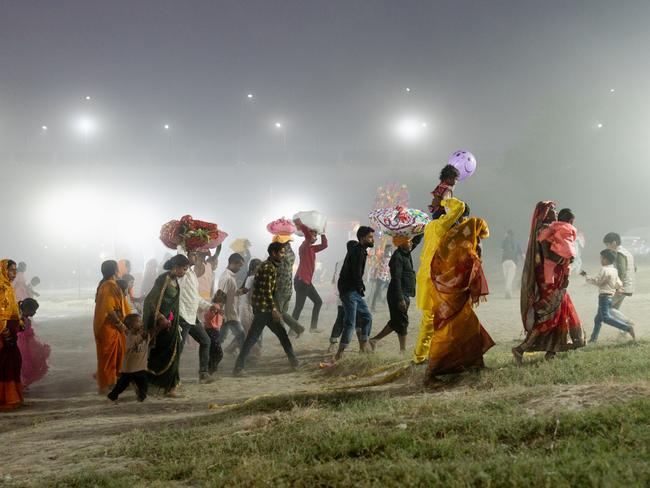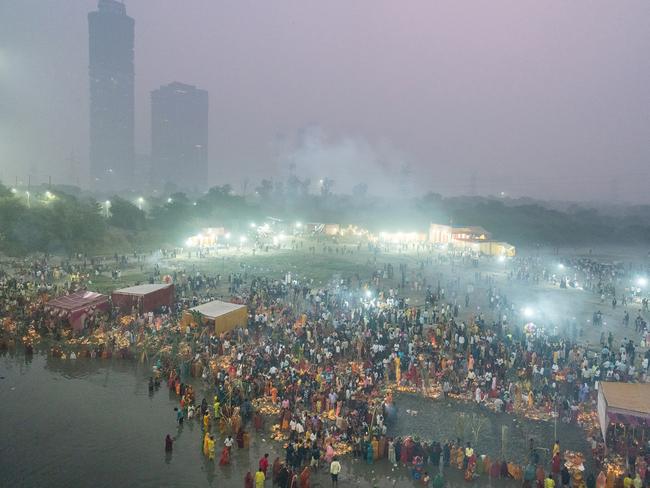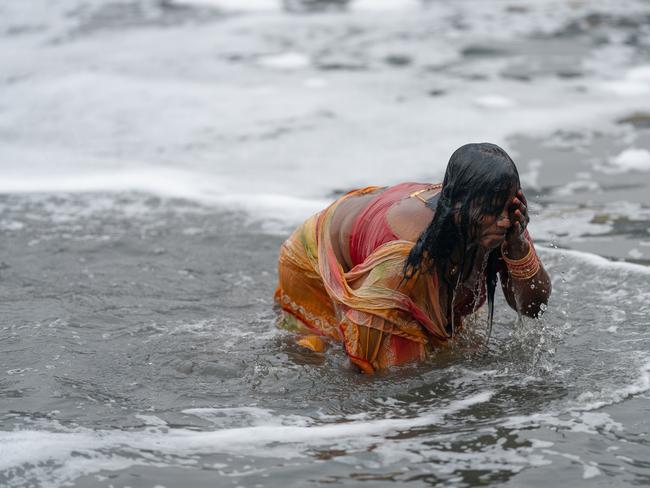‘It stinks, but it’s OK’: Defying warnings, India’s Hindus bathe in holy river polluted with toxic foam
Disturbing footage has emerged of devout worshippers bathing toxic foam, highlighting a growing crisis that is claiming millions of lives.

Sustainability
Don't miss out on the headlines from Sustainability. Followed categories will be added to My News.
Disturbing footage has emerged of devout worshippers bathing in toxic foam, highlighting a growing crisis that is claiming millions of lives.
Sweeping aside thick, lethal scum, thousands of Hindu devotees ignored court warnings last week against bathing in the sacred but sewage-filled Yamuna river, a grim display of environmental degradation in India’s capital.
Thousands celebrated the festival of Chhath Puja for the Hindu sun god Surya on Thursday, November 7, entering the stinking waters to pray as the evening rays set in the sky.
A parliamentary report in February called the Yamuna “more of a toxic waterway than a river”, saying the foam clouds were formed from a potent chemical soup including laundry detergent and phosphates from fertilisers.
“Please understand you will fall sick,” a high court order said the day before the festival, Indian media reported, restricting ritual bathing on health grounds.
“We can’t allow you to go into the water.”

But housewife Krishnawati Devi, 45, said she was not worried. “I believe the waters of the river are pure and blessed by the sun god himself,” she told AFP.
“Nothing will happen to me — god will take care of everything.”
Hindu faithful ignored the order, with women wrapped in fine saris and heavy jewellery wading into the grey waters.
White foam swirled around their feet. In places, it was so thick it looked like the river had frozen.
“Chhath is a festival of unflinching faith,” said Avinash Kumar, 58, a government office worker. “We can also offer prayers at home but it doesn’t feel the same as praying in the river.”
Others thumped drums and sang.

New Delhi’s authorities have poured in anti-foaming agents to disperse the froth, and used nets to sweep the scum away — but it has done nothing to clean the fetid water itself.
“It stinks, but it’s OK,” said 14-year-old schoolgirl Deepa Kumari. “What is important is that we get to celebrate in the river with our people.”
Rituals in the days-long festival culminate at dawn on Friday.
“I don’t bother about the pollution”, said Pooja Prasad, 20, a student. “The mother goddess will take care of all our troubles.”
The sprawling megacity of some 30 million people is also smothered in poisonous smog — fuelled by burning crop fields and vehicle exhaust fumes.
Levels of fine particulate matter — dangerous microparticles known as PM2.5 pollutants that enter the bloodstream through the lungs — have this week surged beyond 50 times the World Health Organisation recommended daily maximum.

“Toxi-city”, broadcasters dubbed the capital.
City authorities have declared repeated efforts to clean the river. From an icy source of a Himalayan glacier, the Yamuna feeds into the mighty Ganges, flowing more than 3100 kilometres to the sea in the Bay of Bengal.
But barely 400 kilometres into that journey, the water passing New Delhi is already effectively dead.
The parliamentary report warned of an “excessive presence of heavy metals” and cancer-causing pollutants ranging from arsenic to zinc, from everything from batteries to pesticides.
“Contamination … transform it into a carrier of untreated industrial waste, garbage, agricultural run-off and municipal waste,” the report read.
“This has a profound effect on the wellbeing of the people.”
Government statistics say 80 per cent of the pollution load is raw sewage, far exceeding permissible levels for bathing.

Some of the faithful have traditionally drunk the water.
Levels fluctuate, but in one spot in 2021 in south Delhi, faecal bacteria levels exceeded maximum health regulations by 8800 times.
But many say they are frustrated at the situation.
“The river is sacred to us, but all the filth from the industrial belt nearby is being pumped into it,” added Mr Kumar.
“Every year they say they are going to clean it, but nothing ever happens.”
The situation is hardly unique to the Yamuna — India has some of the most notoriously polluted waterways on the planet.
Seventy per cent of surface water in India is estimated to be unfit for human consumption, according to the Asian Development Research Institute (ADRI).
Hundreds of millions of people across the country, with its rapidly growing population of 1.4 billion, are exposed to river pollution every year in a growing health and economic crisis.

In 2011, the World Bank noted that around one in every 10 deaths in India is from causes related to inadequate sanitation and hygiene, or about 400,000 lives per year, many children under five.
The report estimated the cost of environmental degradation in India at $US80 billion a year with health costs related to water pollution alone of around $US8.7 billion.
The 2500-kilometre Ganges, which flows from the Himalayas across northern India into the Bay of Bengal in Bangladesh, is considered the holiest river to Hindus but is also the most polluted.
Human corpses are often seen floating in the Ganges, owing to the illegal practice of water burials as many poor people often cannot afford cremation.
In 2015, more than 100 badly decomposed corpses were found washed up in a shallow tributary of the Ganges near the village of Pariyar in Uttar Pradesh.

“These traditions [of placing the dead in the river] are actually becoming a health hazard with the dead bodies rotting instead of flowing off in the river,” Mallika Bhanot from river conservation non-profit Ganga Ahvaan told news channel CNN-IBN at the time.
“Earlier it used to flow into the river and the fishes and everything used to feed on it and it was something that was going [on] harmoniously [with nature].”
Indian Prime Minister Narendra Modi has long promised to clean up the country’s rivers, including by building millions of toilets to discourage open defecation, but little apparent progress has been made.
Poor infrastructure means at least half of India’s sewage is not treated and discharged directly into waterways, while lax enforcement of environmental regulations sees most factories continue to dump their waste into rivers.

“Every country in the world faces challenges with pollution but India is a huge country, with a high population density and a high rate of urbanisation,” Nitin Bassi from India’s Council on Energy, Environment and Water told The Telegraph in 2022.
“Of course, therefore, the scale of the problem in India is much bigger than other nations.”
In central India’s Jharkhand province, villagers drink thick black water scooped from the Damodar river, choked with ash from local coal stations and mining companies, household waste and animal carcasses.
“We have used this water for drinking and bathing since I was a small child,” Tuklal Mahto told the newspaper.
“But the numbers of people getting sick from using the water are increasing and we don’t have any other alternative. We have lived in this area for generations, our homes are here. The river has definitely gotten dirtier in recent years. The water is so dusty and polluted that it is making all of the children sick. We don’t have any money to migrate so we are stuck here drinking this garbage water.”
Originally published as ‘It stinks, but it’s OK’: Defying warnings, India’s Hindus bathe in holy river polluted with toxic foam




